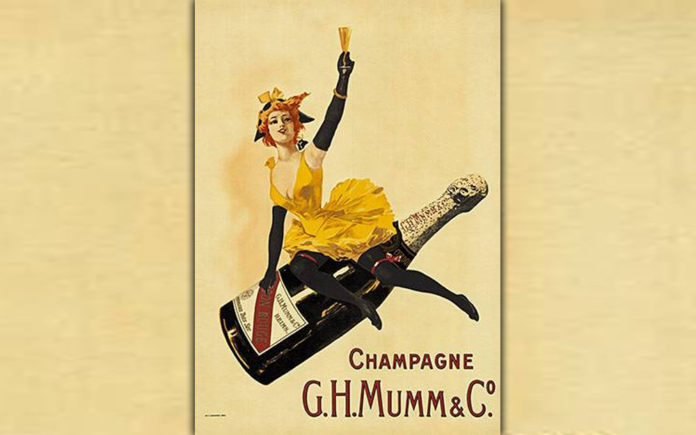
BY RICK RIOZZA
Whenever you need to step back from all of the pressures of gifting here and gifting there, do keep in mind that there’s no better gift than a bottle of French Champagne. We know the best gifts are from the heart, so do take a little time to to make a personal connection in considering the type of wine you’re getting the individual. Whether the recipient is a lover, a friend, a client or a boss, you can be sure the thoughtfulness of a particular selection will not be lost.
So many of us have a favorite or go-to French Champagne and/or labels that we simply look for, without really thinking about why this brand or that?
Almost no other wine has such a broad range, and all of your famous Champagne houses amazingly maintain their stylistic profile. By mixing the grape varieties available to them in the Champagne region—Chardonnay, Pinot Noir, and Pinot Meunier—from different vineyards and different vintages along with their altering dosages depending on the year’s weather, each champagne producer has the opportunity to confer each cuvée with its own personal character.
So many different styles exist such as light with finesse or full and stunning. They can be fruity and flowery, fresh or mature, sweet or very dry. Even in the case of the most popular style of champagne—non-vintage (dry) brut—there are big differences.
Let’s review the Champagne labels that you’re often familiar with and discuss what they are about:
Veuve Clicquot Ponsardin/Brut Yellow Label is of course one of the most popular French bubbly around. This wine has a high proportion of Pinot Noir in the blend, and thus is known for a full, rich, and opulent style of Champagne. The nose shows some aged aromas of buttered baguette and honey, and in the mouth ripe red berry and yellow stone fruits, along with some bready characters; lots of very small bubbles and finishes with a clean, bright, crisp apple-like bite.
Moët & Chandon Impérial: The company sells 30 million bottles annually, which represents almost 10% of all Champagne consumed worldwide. Straight ahead stuff, that’s consistent. The Impérial nose combines smoky aroma along with citrus and some ripe fruit and honey. In the mouth, the Brut is fresh and bright, with apple, lemon and chalk flavours, but also, at its core, some honey and bread. A persistent, refreshing and precise Champagne. It’s been said that this style epitomizes the Champagne region.
Piper-Heidsieck Cuvée Brut Non-Vintage: Piper-Heidsieck sells 4.3 million bottles annually. A classic style, well balanced. Piper’s Cuvée, with a high proportion of Pinot Noir, has a wonderful, inviting nose with aromas of toast and smoke along with a touch of honey and yellow fruit. The same continues in the palate, with lots of smoky toastiness and ripe yellow fruit. It finishes with a chalky palate-cleansing freshness. In blind tastings, this Champagne consistently comes out top among the 10 biggest labels, which makes this full style the best of the big-brand Bruts.
Pommery Brut Royal Non-Vintage Pommery: Pommery sells 4.38 million bottles annually. Known for its acidity, harmonious, fresh; This Champagne has equal amounts of Chardonnay, Pinot Noir, and Pinot Meunier. White flowers and honey dominate the nose of Pommery’s Brut NV, and persist on the palate too. Combined with these flavors are bright characters from youthful, fresh lemon notes to a chalky sensation on the finish. Quite a delicate and lively style of Champagne, with a touch of honey providing depth and roundness.
Taittinger Brut Réserve Non-Vintage: Taittinger sells 5.5 million bottles annually. It’s fruity with good mouthfeel; This Chardonnay-dominant Champagne has lovely aromas of citrus, honey and a background bready note. The palate displays some fullness, with ripe yellow fruit, along with honey, before it finishes with a fresh lemony character. A creamy but bright, youthful and very reliable Brut NV Champagne.
Laurent-Perrier sells 7.26 million bottles annually and is known for lively complex fruity tones. Like Taittinger, Laurent-Perrier’s Brut NV has a high proportion of Chardonnay in the blend, though it is a slightly lighter, firmer style of Champagne. On the nose, it delivers a touch of toast and smokiness, along with youthful characters of green apple and citrus. In the mouth, there is a touch of honey and toast, balanced by crisp apple, and a dry chalky finish.
Mumm sells 7.55 million bottles annually. Quality improvements at this house are really making their mark on this big-brand Brut, and Mumm has an appealing nose of yellow fruit, apple and a touch of honey and crusty bread. The same attractive characters dominate the palate, with a core of ripe fruit, including some red berry flavours, along with a hint of brioche and honey. The finish is clean and bright with citrus and chalk. It’s a good quality, good value, high volume Champagne.
Lanson’s Black Label Brut NV: Aromas of toast, citrus and green apple characterise the nose of Lanson’s Brut NV, called Black Label. In the mouth, the Champagne has a firm, fresh, linear character, with a touch of lemon peel on the finish, and a hint of toast too. This is a bright, fresh style of Champagne, making it an excellent aperitif.
Nicolas Feuillatte Brut Reserve: Feuillatte sells 10.8 million bottles annually. This bottle sells at around $30. France’s best-selling Champagne brand combines slightly green fruit characters with some appealing toast and honey aromas. In the mouth, some attractive evolved honeyed flavors are balanced by crisp apple notes, making the Champagne bright but a balanced and pleasant blend of young and more aged flavors.
And generally speaking, Krug Grand Cuveé is a wine full of finesse; Louis Roederer owns fine fruit, is balanced and elegant; and Pol Roger is harmonious, elegant, with complex aromas.
Joyeux Noël & Bonne fêtes—À Santé!











































